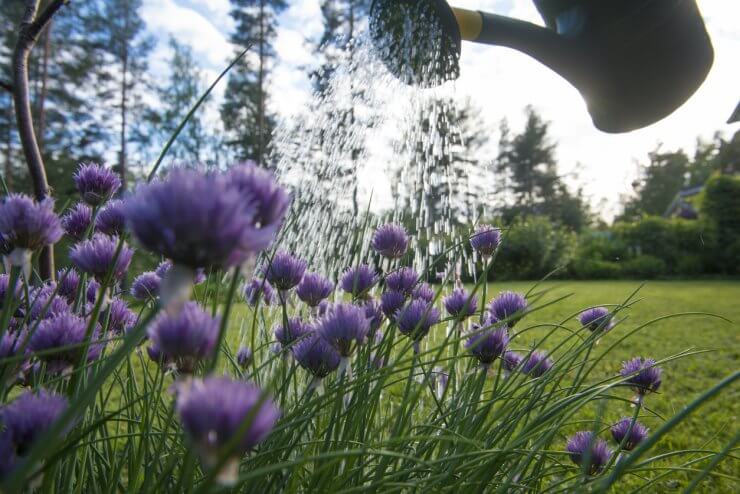
Watering chives in the garden
Water
Once your chives are settled in—whether it’s in a container, a raised bed, or open ground—consistency is key when it comes to watering. If you don’t get rain on a regular basis, go out and give your chives a good drink of water. Chives like soil that’s moist, but not soggy.
In general, you’ll want to water deeply about once a week. If the top of the soil is a little dry, that’s OK. But don’t let the soil dry out. Lay down a layer of mulch to help retain moisture; ground-up leaves, clean grass clippings (no pesticides), or compost work well.
It’s always best to water in the morning, so your plants can soak up the water and put it to work. Watering earlier in the day also gives the sun time to burn off any water on the leaves. When you do water, aim for the base of the plant. Try not to get the leaves wet; that can open the plant to fungal infection.
Weeding
If you’ve planted in raised beds or containers, weeds shouldn’t be much of a problem. If you do see weeds, pull them early and often. Your chive plants have shallow roots systems, and they don’t want to compete with weeds for water and nutrients.
Properly preparing your soil is an excellent preventive measure against the emergence of weeds. When you till or cultivate the area where you’ll plant your chives, remove weeds and debris. You’ll likely find that the first few weeks after planting are the only time you’ll be pulling up weeds around your plants.
If weeds spring up around your chives during the growing season, work the soil around the base of the plants with a hand rake—only deep enough to kill the weeds and not damage the plant’s roots.
Fertilizer
Over-fertilizing can be the kiss of death for chives. They can do with a liquid fertilizer prepared at half the strength recommended on the label; apply this every four to six weeks during the growing season. If you have plants that are beginning to flag after years of successive harvests, you can treat them with a very light application of a 5-10-5 fertilizer once in the spring. Other than that, let them do their thing.
How often do you have to fertilize or water your chives? Do you have any particular challenges growing chives? Please tell us your tips for nurturing healthy chives.


 Previous
Previous

